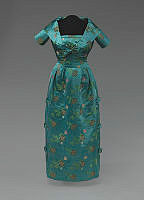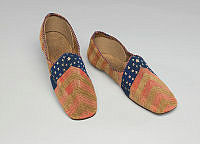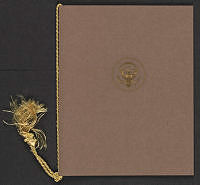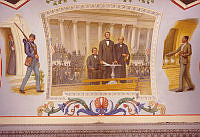Rubenstein Center Scholarship
Daniel Webster's House
This article is part of the Slavery in the President’s Neighborhood initiative. Explore the Timeline
At the corner of H Street and Connecticut Avenue, the United States Chamber of Commerce Building sits where a three-and-a-half story brick house once stood. The house was built in 1828 by attorney Thomas Swann.1 Swann was born in Charles County, Maryland, and in 1787 he moved to Alexandria, Virginia, where he studied law, married Jane Byrd Page, and started a family. Swann served as the United States Attorney for the District of Columbia from 1821 to 1833.2 In 1841, Senator Daniel Webster rented Swann’s house when he became the United States Secretary of State, and he purchased the house shortly thereafter on July 1, 1841.3 He resided in the home while serving as secretary of state under President William Henry Harrison and President John Tyler. However, Webster’s tendency to overspend left him in debt constantly, and the house proved too expensive for him to maintain, so he moved from the house on Lafayette Square to a house on D Street during 1846.4 Click here to learn more about the enslaved households of President John Tyler.
Although Webster’s residence at the Lafayette Square house lasted only about five years, he impacted the lives of many enslaved African Americans while living in the President’s Neighborhood. While he personally opposed the idea of slave ownership, Webster himself used enslaved labor at his home but with a twist—he would purchase the freedom of workers and in return they worked for him to pay off their debt. This was not unusual for the time, but it speaks to the complicated and sometimes conflicting views that Webster and others had toward slavery. Since Webster enjoyed an expensive lifestyle and generally managed his money poorly, he rarely could afford to purchase the freedom of his enslaved staff members in full.5 As a result, Webster drew up agreements with enslaved workers so that they could earn a wage while they worked for him. With the money from their wages, Webster’s enslaved servants could repay their debt, and eventually purchase their freedom. Although Webster opposed slavery and purchased enslaved individuals with the intention of freeing them, he also benefited from the arrangement while his enslaved staff members worked off their debt.

A portrait of Daniel Webster painted by Chester Harding.
Library of CongressThere are few sources written or published by the enslaved people who worked for Webster under these conditions. Webster’s correspondence occasionally mentions his staff members. When Webster and his family members reference their domestic staff, they use the term “servant” when referring to both free and enslaved workers. When possible, this article refers to the roles of his individual staff members as well as their state of enslavement or freedom. However, due to the lack of source material from the Websters, the term “servant” is used when the specific positions of household staff members are unclear or not defined.
Most of the information about the enslaved individuals that Webster purchased comes from other peoples’ observations about his household. Thus, the experiences of Webster’s domestic staff as well as Webster’s intentions for purchasing and freeing enslaved individuals are presented through the perspectives of Webster’s friends and family. Although these narratives provide insight into the lives of enslaved individuals, they may include elements of bias and exaggeration.
Peter Harvey’s 1877 biography Reminiscences and Anecdotes of Daniel Webster provides the most information about Webster’s household staff. Other biographies tend to focus on Webster's political career and family members, and rarely include accounts or mention of his domestic staff. Harvey’s work is one of the only sources that describes these individuals by name and Webster’s rapport with his workers. As one of Webster’s close friends, Harvey wrote and compiled his memories of Webster to commemorate his life and work. Since Webster was a prominent political figure, Harvey was proud of his connection to Daniel Webster. An article about Harvey’s Reminiscences in the Chicago Tribune reported, “It was Mr. Harvey’s pride and boast that he had been received into the intimate confidence—a confidence yielded to but few—of Daniel Webster.”6 By demonstrating knowledge of Webster's affairs and writing about his interactions with household staff, Harvey's work projected intimacy with the Webster family and familiarity with their everyday life.7

After Webster moved out, William Wilson Corcoran purchased the house on Lafayette Square in 1849 and resided there until 1888. Corcoran commissioned architect James Renwick, Jr. to transform the Federal-style townhouse into an Italianate palazzo.
Library of CongressWhile it provides key details about the workers of Webster's household, Reminiscences was also a product of its time. Nineteenth-century biographies were generally not written with the amount of research and documentation expected of histories written today. They were also more sympathetic in their portrayal of prominent individuals, especially if the author knew the subject personally, and they sometimes included exaggeration or embellishment. Reminiscences was written twenty-five years after Webster’s death, and shortly before Harvey’s.8 Since Harvey was friends with Webster, one must be cautious of the source and its claims.9 His stories frequently position Webster as a friend to enslaved individuals and his household staff. Likewise, his portrayal of Webster’s interaction with enslaved individuals often includes descriptions of their loyalty, devotion, and affection toward Webster—unfortunately, Webster did not write about his relationships with his workers or his intentions when purchasing their freedom. While Harvey’s account provides some of the best information available about Webster’s domestic staff, his observations must be carefully considered.
Sometime during the 1820s, Webster helped an enslaved woman named Monica McCarty purchase her freedom. McCarty was born in Virginia around 1800. She was enslaved by D.C. Circuit Court judge William Cranch and was known for her skills as a cook. When she was around twenty years old, Cranch began hiring Monica out to acquire additional money from her labor. She was hired out to Daniel Webster for one of her jobs, and Webster was impressed by her culinary expertise. When Cranch offered to sell Monica to him, Webster purchased her freedom for $600 and employed her as a cook. Since he could not afford the entire price in full, Webster paid a $100 down payment and agreed to complete the remainder in installments.10
Employed as a cook at Webster’s house on Lafayette Square, Monica earned a wage from Webster so she could pay him back over time. In a memoranda written on July 24, year unknown, Daniel Webster wrote, “Up to this time, pd Monica 26 Dlls.”11 This exchange could be a reference to the wages that Monica earned as a cook. According to Harvey, despite their original work agreement, Webster never asked Monica to pay him back for purchasing her freedom. He goes on to suggest that Webster let Monica keep the wages she earned from her work. Harvey wrote, “Monica told me that he always paid wages to her without any reference to the money that he had paid for her freedom; that she had always had full wages, and that she had never had to spend a dollar for clothes, Mrs. Webster, by presents and otherwise, furnishing her with them.”12

Portrait of Judge William Cranch take by Matthew B. Brady. Cranch was the Chief Justice of the Circuit Court of the District of Columbia.
Library of CongressMonica’s cooking skills became well known among Webster’s dinner guests, and he enjoyed hosting elaborate dinners to show off her culinary abilities. In April 1842, Secretary of State Webster negotiated a treaty to settle Canadian border disputes with Alexander Baring, 1st Baron Ashburton. To help the treaty negotiations run smoothly, Lord Ashburton rented a house next to St. John’s Church, which was near Webster’s residence on Lafayette Square.13 During the Baron’s time in D.C., Lord Ashburton and Webster enjoyed socializing and hosting dinner parties. City chronicler Samuel Busey reported that “balls, evening parties, and receptions and dinners succeeded in such impetuous haste that it seemed like a continuous stream of fashionable display and brilliant entertainment in which the two distinguished diplomats engaged in the negotiation of the treaty to adjust the differences between England and this country vied with each other in rivalry for the social honors.”14 Lord Ashburton and Webster also competed to serve the most impressive dishes while they discussed treaty terms.15 For the dinners that Webster hosted, Monica prepared American-style delicacies, including “Maine salmon, Massachusetts mackerel, New Jersey oysters, Florida shad, Kentucky beef, West Virginia mutton, Illinois prairie chickens, Virginia terrapins, Maryland crabs, Delaware canvasback ducks and South Carolina ricebirds.”16 At the conclusion of the dinners, Lord Ashburton agreed that he enjoyed Monica’s American-style cooking more than the European dishes served by his own staff.17
In addition to serving the dishes that Monica prepared, Webster shared her recipes with friends. In a memoranda to journalist William Winston Seaton, Webster recorded one of Monica’s recipes:
These are black fish, sometimes called Tautog. Monica cooks them thus:--Put the fish into a pan with a little butter, and let them fry till pretty nearly cooked, then put in a little wine and pepper and salt, and let them stew. She uses no water. A little more wine, pepper, and salt to make a good gravy. So says Monica, who stands at my elbow at half past five o’clock. A good way to also make agreeable table companions of these fellows is to barbecue or broil them without splitting.18
Monica continued to work for Webster until his death in 1852, and according to Harvey she saved nearly $2,000 from her time working for Webster.19
After Webster’s death, Harvey claimed that Franklin Pierce approached him with a job opportunity for Monica; however, there is little documentation to confirm his story. According to Harvey, when Franklin Pierce became president in 1853, he asked Harvey if Monica would manage the White House kitchen staff.20 Webster and Pierce had developed a friendship during their years working in D.C., and Webster invited Pierce to his social events. In a letter to his friend Edward Curtis, Webster mentions inviting Pierce to a gathering with friends at his family home in Franklin, Massachusetts.21 Harvey also recalled Pierce visiting Webster at his house in D.C.22 Since Pierce attended Webster’s social events, he may have enjoyed Monica’s cooking during several occasions. However, beyond Harvey’s recollection, there is no other known evidence to support this claim. Additionally, since Monica was a freed by Webster, one wonders why Pierce relayed the offer through Harvey rather than directly addressing Monica about the opportunity.
Her response to Pierce’s offer seems even more dubious. In Harvey’s account of the story, Monica declined Pierce’s offer: “No, to be sure I won’t. After I have been Mr. Webster’s cook, I never will be General Pierce’s. I’ll come and cook for you, Mr. Harvey, but I wouldn’t cook for General Pierce.”23 Harvey recalled that Monica refused to work for Pierce out of loyalty to Webster. However, there are no personal accounts from Monica that confirm her sentiments toward Webster or Harvey. It seems peculiar that she would not seriously consider such an opportunity—so much so that one wonders if Harvey embellished or fabricated this story and its dialogue.
When Henry Pleasants was a young boy, he also obtained his freedom with Webster’s assistance. Henry Pleasants was born in 1817, and he was enslaved at a boardinghouse where government officials often stayed while visiting Washington, D.C. Webster met Henry at the boardinghouse. After seeing the cruel treatment that Henry faced from his owners, Webster decided to help Henry obtain his freedom. Webster purchased Henry’s freedom for $500.24 Although sources that reference Henry’s life suggest that he grew up in the Webster household, it is unclear whether Henry was employed by Webster.

Photograph of the United States Chamber of Commerce building.
Library of CongressIn 1846, Henry married Frances Posey, and their daughter Ann was born in 1847.25 After Ann was born, Henry accompanied Webster’s son Edward during the Mexican-American War. Since Henry and Edward were close in age, the two became friends as they grew up together. Edward joined the First Massachusetts Volunteer Regiment in January 1847; however, the regiment faced difficulty obtaining enough funding to join the war effort for several months.26 When his regiment finally obtained adequate resources and orders to depart for Mexico, Daniel Webster asked Henry to accompany Edward. Henry agreed, and he traveled with Edward. Before the regiment’s departure, Webster wrote a letter to Edward and stated, “Take good care of Henry. There is no one else he wd. have gone with.”27
The regiment arrived in Brazos, Mexico, in April 1847 where they were stationed at the Matamoros garrison. Daniel Webster and his wife Caroline Le Roy Webster sent letters to Edward with updates about family and friends. They also mentioned Henry in their correspondence and shared updates about household staff. In one letter, Caroline wrote, “I hope you find Henry useful & that he is reconciled to his seperation [sic] from home. His wife & family are well…All the Servants in the house think that you & Henry comprise the Army.”28 While they were in Brazos, Henry and Edward became ill. Both recovered enough to return to the United States for a leave of absence. In November 1847, Edward and Henry rejoined the regiment in Perote, Mexico.29 When they returned to Mexico, Henry became ill again, and Edward contracted typhoid fever. Henry tended to Edward and reported his health conditions in a letter to Daniel Webster on January 12, 1848:
Sir i take this Liberty to inform you although i think the Major will be angery with me an atact somthing the Same as he had at Matamoras the Doctor Caled this Morning and he thinks he is a great deal better this Morning he got up and Shaved himself the first time for ten Days i myself think he is improveing very fast for i have been up with him the last ten nights and his rest is much Better now than it has been i hope you and Mrs Webster ar well Pleas not say any thing in your writing to the Major that i wrote to you of his sickness he may not like it as i did not say any thing to him about it Remember me to all the Family Pleas tell Georg to send me the inteligencer mention me to my Family and say that i have been very Sick but i have Recovered i think it is a very Unhealthy Country i Remain your humble Servant
Henery Pleasants30
Despite brief signs of improvement, Edward’s health continued to decline. He passed away in San Angel, Mexico on January 23, 1848. Henry brought Edward’s body home to the Websters’ estate in Marshfield, Massachusetts for burial.31
Another woman, Ann Bean, sought to free her husband from slavery. Ann gained her freedom during the 1840s, and she worked for Webster. Her husband, referred to as “Bean” in most sources, was still enslaved to merchants in Alexandria, Virginia.32 Webster did not have adequate funds to purchase Bean’s freedom; however, he helped Bean negotiate an agreement with his owners. When the merchants agreed to let Bean purchase his freedom for $1,500, Webster helped Bean set up an account with a banker in D.C. to accumulate interest on the occasional money he earned from his owners.33 Bean worked diligently to save enough money, and by 1846 he only needed $200 more to purchase his freedom.
In June 1846, Bean visited Ann at Webster’s house on D Street. During the visit, Bean also shared his progress with Webster and Peter Harvey. In Harvey’s Reminiscences, he details a conversation between Webster and Bean. According to Harvey, Bean declared, “I am spending nothing; and I am looking for the hour to arrive in which I shall be a free man. I make every corner cut, and where I can’t make it cut, I make it bruise.” Webster replied, “Go on; don’t relax a muscle.”34 Webster encouraged Bean to remain persistent, and he promised to provide the remaining money needed for Bean’s purchase price in September. In September 1846, Webster contributed the remaining $60 to purchase Bean’s freedom. Beyond Harvey’s account, there is no other known evidence to support the details of Bean’s conversation with Webster and Webster’s contribution to Bean’s freedom.

Daniel Webster’s law office and residence at 503 D Street.
Library of CongressIn 1847, Paul Jennings also worked out an agreement with Webster to purchase his freedom. Paul was formerly enslaved by James and Dolley Madison. He was born in 1799 at Montpelier, the Madison’s estate in Virginia. When James Madison became president, he became the president’s personal valet and the first lady’s dining room servant. After Madison’s presidency, Paul continued to work as a manservant at Montpelier until James Madison’s death in 1836. After James’s death, Dolley Madison ordered Paul to return to Washington with her, separating him from his wife Fanny and their five children.35 During the spring of 1844, Jennings learned that Fanny’s health was failing. Jennings gained permission from Mrs. Madison to visit Fanny during her illness. In August 1844, Fanny passed away with Paul and their children at her side.36 The Madison family did not give Paul much time to mourn with his family. The day after his wife’s death, Mrs. Madison’s son Payne Todd sent Paul back to Washington. Before leaving, Jennings sent a letter to Mrs. Madison and stated, “I return to you a thousand thanks for your kindness in permitting me to stay with my wife untill [sic] her departure from this life which took place yesterday after great suffering—I trust she has gone to a world where sorrowing and suffering are no more.”37 Click here to learn more about the enslaved households of President James Madison.
In Washington, Mrs. Madison hired out Paul to help pay off her debts. For several months during 1845, Mrs. Madison hired out Jennings to work for President James K. Polk at the White House. However, the money she received from Paul’s work at the White House could not cover all of her expenses. In September 1846, Mrs. Madison sold Paul to local insurance agent Pollard Webb. About six months later, Webster offered to purchase Paul’s freedom from Webb, and Webster arranged a work agreement with Jennings. In their agreement Webster wrote: “I have paid $120 for the Freedom of Paul Jennings—He agrees to work out the sum, at 8 dollars a month.”38 Jennings fulfilled the terms of the work agreement, and he obtained his freedom in 1848. After he gained his freedom, Paul continued working for Webster until 1851. Click here to learn more about the enslaved household of President James K. Polk.
Gallery
-

This is the recommendation letter that Daniel Webster's wrote for Paul Jennings. on June 23, 1851.
University of North Carolina at Chapel Hill, The Southern Historical Collection, Alfred Chapman Papers -

This is the recommendation letter that Daniel Webster's wrote for Paul Jennings. on June 23, 1851.
University of North Carolina at Chapel Hill, The Southern Historical Collection, Alfred Chapman Papers
While working for Webster, Paul lived in a house with three other members of D.C.’s free African-American community: Sarah Smith, Lucretia Smith, and George Green. Although it is unclear when Paul first moved to the house, records from the 1850 United States Federal Census indicate that Paul was living with them.39 Sarah Smith was likely his coworker, since a woman named Sarah Smith also worked as a servant for Webster. She and Jennings may have walked together to work at Webster’s house on D Street.
Although he no longer worked for the Madison household, Paul remained in contact with Mrs. Madison and occasionally visited her at the Cutts-Madison House in Lafayette Square. Concerned for her health, Webster often sent Paul to Mrs. Madison with provisions from the market. In his memoir, A Colored Man’s Reminiscences of James Madison (1865), Paul references his visits with Mrs. Madison: “While I was a servant to Mr. Webster, he often sent me to her with a market-basket full of provision, and told me whenever I saw anything in the house that I thought she was in need of, to take it to her. I often did this, and occasionally gave her small sums from my own pocket, though I had years before bought my freedom of her.”40 Paul’s memoir about his experiences working for James and Dolley Madison was the first book published by a formerly enslaved White House worker.

A photograph of Paul Jennings by the E.C. Perry Photograph Company.
The Estate of Sylvia Jennings AlexanderIn June 1849, Jennings married Desdemona Brooks, and the two purchased a home at L and 18th Street, which was located within walking distance of the White House.41 Paul began seeking employment opportunities outside of Webster’s household in 1851. Webster supported Paul by writing a recommendation letter for him on June 23, 1851: “Paul Jennings was a servant in our house, for a considerable time. We think him very honest, faithful and sober; and a competent dining room servant. Formerly he was a body servant to Mr. Madison.”42 Jennings found work as a laborer at the Pension Office, a section of the Department of Interior. His responsibilities involved assignments such as message running and door keeping.43
In October 1852, Webster’s health was failing. He had recently purchased the freedom of William Johnson, and Johnson worked as Webster’s valet during his final illness.44 In his will, Webster included a statement ensuring that Johnson gained freedom after his death. Webster declared, “My servant, William Johnson, is a free man. I bought his freedom not long ago for six hundred dollars. No demand is to be made upon him for any portion of this sum, but so long as is agreeable I hope he will remain with the family.”45 Although Ann Bean and Sarah Smith were already free and Webster purchased Monica McCarty’s freedom, Webster also included statements about specific African-American workers to ensure that they maintained their freedom after his death. Webster’s will stated: “Monicha [sic] McCarty, Sarah Smith, and Ann Bean, colored persons, now also, and for a long time in my service, are all free. The[y] are very well-deserving, and whoever comes after me must be kind to them.”46
After Webster moved out of his house on Lafayette Square, William Wilson Corcoran purchased the house in 1849 and resided in the house until 1888.47 Following Corcoran, Ohio Senator Calvin S. Brice and New York Senator Chauncey M. Depew occupied the house as tenants. William Corcoran Eustis, grandson of W. W. Corcoran, was the last person to reside in the house before it the property was sold in 1912 and demolished to make space for the United States Chamber of Commerce.48

Paul Jennings' work agreement with Daniel Webster.
Moorland-Spingarn Research Center, Howard University









